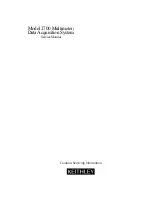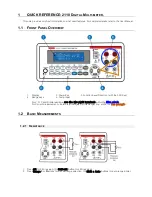
19
FR
M1.1.MWM1200.NLFREN 23082018
Input Terminals
COM Common (return) terminal for all
measurements.
V
Ω
Hz
Input terminal for the measurements of:
1. AC/DC voltage
2. Resistance
3. Capacitance
4. Frequency
5. Temperature
6. Continuity
7. Diode
8. Duty cycle
9. AC/DC current to 6000
μ
A
10
COM
V
Ω
Hz
3�4 Bornes d’entrée
Borne d’entrée pour mesurer :
1. Tension AC/DC
2. Résistance
3. Capacitance
4. Fréquence
5. Température
6. Continuité
7. Diode
8. Cycle de travail
9. Courant AC/DC jusque 6000 µA
Borne commune (retour) pour toutes les
mesures
4 Instructions de mesures
4�1 Mesure de tension AC/DC
1.
Branchez le cordon de test noir à la borne COM et le cordon rouge à la borne VΩHz.
2. Tournez le bouton rotatif sur .
3. Appuyez sur SELECT pour basculer entre AC/DC.
4. Mettez les sondes aux points de test corrects du circuit pour mesurer la tension.
5. Lisez la tension mesurée sur l’écran.
*Ne mesurez pas une tension qui dépasse les limites indiquées dans les spécifications.
*Ne touchez pas le circuit haute tension pendant les mesures�
4�2 Mesure de courant AC/DC
1. Pour un courant < 6000 µA :
a.
Branchez le cordon de test noir à la borne COM et le cordon rouge à la borne VΩHz.
b. Tournez le bouton rotatif sur .
c. Appuyez sur SELECT pour basculer entre AC/DC.
d.
Coupez circuit à mesurer, connectez les fils de test à travers le disjoncteur et mettez sous tension.
2. Pour un courant > 6000 µA :
a. Tournez le bouton rotatif sur .
b. Appuyez sur SELECT pour basculer entre AC/DC.
c.
Ouvrez la pince et centrez le fil entre les mâchoires (comme illustré ci-contre).
3. Lisez le courant mesuré sur l’écran.
*Ne mesurez pas un courant qui dépasse les limites indiquées dans les spécifications.
*Utilisez d’abord le bouton d’ouverture de la pince et le mode pour mesurer un courant
inconnu. Passez ensuite à la borne VΩHz et en mode µA si nécessaire.
*Mesurez sur un fil à la fois, cas les courants se déplaçant dans des directions différentes vont s’annuler
mutuellement�
*N’introduisez pas de tension dans ce réglage�
Input Terminals
COM Common (return) terminal for all
measurements.
V
Ω
Hz
Input terminal for the measurements of:
1. AC/DC voltage
2. Resistance
3. Capacitance
4. Frequency
5. Temperature
6. Continuity
7. Diode
8. Duty cycle
9. AC/DC current to 6000
μ
A
10
COM
V
Ω
Hz
6
Function Buttons
①
②
①
Selects alternate measurement modes on a
rotary switch setting, including:
1. DC V/AC V
2. Resistance/Continuity/Diode/Capacitance
3. Celsius/Fahrenheit
4. DC
μ
A/AC
μ
A
5. DC A/AC A
②
When the rotary switch is at , push
SELECT once to toggle to AC V testing
mode, then push this button to enter
Frequency/Duty Cycle (with high voltage)
testing mode.
When the rotary switch is at , push this
button to enter Frequency/Duty Cycle (with
low voltage) testing mode.
③
④
12
b) Turn the rotary switch to
.
c) Press SELECT to toggle between AC/DC
d) Break the circuit path to be measured,
connect the test leads across the break and
apply power.
3. Read the measured current on the display.
2. For current
>
6000
μ
A:
a. Turn the rotary switch to
b. Press
SELECT
to
toggle
between AC/DC.
c. Push the jaw release and center
the wire within the clamp jaws
(as in the picture).
*Do not measure current that exceeds the extremes
as indicated in the Specifications.
*Use the release jaw and the
Mode first
when you are measuring an unknown current.
Then switch to the
VΩHz
Terminal and the
Mode if necessary.
*Measure one wire at a time because currents
moving in different directions will cancel each
other out.
*Do not input voltage at this setting.
12
b) Turn the rotary switch to
.
c) Press SELECT to toggle between AC/DC
d) Break the circuit path to be measured,
connect the test leads across the break and
apply power.
3. Read the measured current on the display.
2. For current
>
6000
μ
A:
a. Turn the rotary switch to
b. Press
SELECT
to
toggle
between AC/DC.
c. Push the jaw release and center
the wire within the clamp jaws
(as in the picture).
*Do not measure current that exceeds the extremes
as indicated in the Specifications.
*Use the release jaw and the
Mode first
when you are measuring an unknown current.
Then switch to the
VΩHz
Terminal and the
Mode if necessary.
*Measure one wire at a time because currents
moving in different directions will cancel each
other out.
*Do not input voltage at this setting.
12
b) Turn the rotary switch to
.
c) Press SELECT to toggle between AC/DC
d) Break the circuit path to be measured,
connect the test leads across the break and
apply power.
3. Read the measured current on the display.
2. For current
>
6000
μ
A:
a. Turn the rotary switch to
b. Press
SELECT
to
toggle
between AC/DC.
c. Push the jaw release and center
the wire within the clamp jaws
(as in the picture).
*Do not measure current that exceeds the extremes
as indicated in the Specifications.
*Use the release jaw and the
Mode first
when you are measuring an unknown current.
Then switch to the
VΩHz
Terminal and the
Mode if necessary.
*Measure one wire at a time because currents
moving in different directions will cancel each
other out.
*Do not input voltage at this setting.
12
b) Turn the rotary switch to
.
c) Press SELECT to toggle between AC/DC
d) Break the circuit path to be measured,
connect the test leads across the break and
apply power.
3. Read the measured current on the display.
2. For current
>
6000
μ
A:
a. Turn the rotary switch to
b. Press
SELECT
to
toggle
between AC/DC.
c. Push the jaw release and center
the wire within the clamp jaws
(as in the picture).
*Do not measure current that exceeds the extremes
as indicated in the Specifications.
*Use the release jaw and the
Mode first
when you are measuring an unknown current.
Then switch to the
VΩHz
Terminal and the
Mode if necessary.
*Measure one wire at a time because currents
moving in different directions will cancel each
other out.
*Do not input voltage at this setting.
copyrighted
document
- all
rights
reserved
by
FBC














































